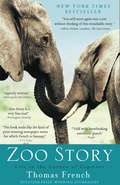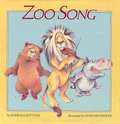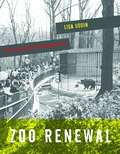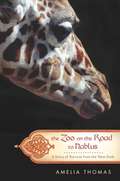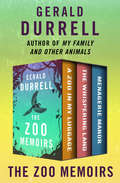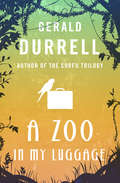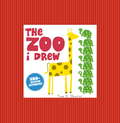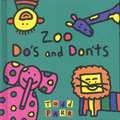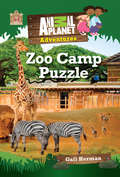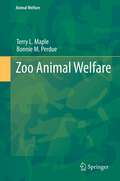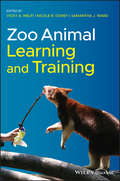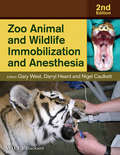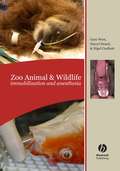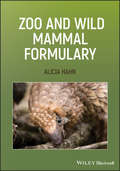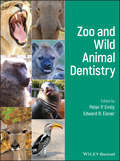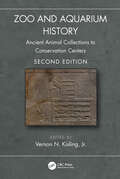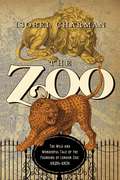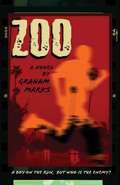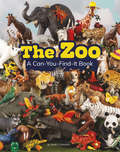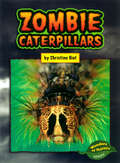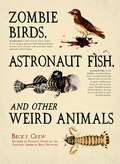- Table View
- List View
Zoo Story: Life in the Garden of Captives
by Thomas French"This story, told by a master teller of such things, does more than take you inside the cages, fences, and walls of a zoo. It takes you inside the human heart, and an elephant's, and a primate's, and on and on. Tom French did in this book what he always does. He took real life and wrote it down for us, with eloquence and feeling and aching detail."-Rick Bragg, Pulitzer Prize-winning journalist and bestselling author"An insightful and detailed look at the complex life of a zoo and its denizens, both animal and human."-Yann Martel, author of Life of Pi and Beatrice and VirgilWelcome to the savage and surprising world of Zoo Story, an unprecedented account of the secret life of a zoo and its inhabitants. Based on six years of research, the book follows a handful of unforgettable characters at Tampa's Lowry Park Zoo: an alpha chimp with a weakness for blondes, a ferocious tiger who revels in Obsession perfume, and a brilliant but tyrannical CEO known as El Diablo Blanco. The sweeping narrative takes the reader from the African savannah to the forests of Panama and deep into the inner workings of a place some describe as a sanctuary and others condemn as a prison. Zoo Story shows us how these remarkable individuals live, how some die, and what their experiences reveal about the human desire to both exalt and control nature.
Zoo Song
by Barbara BottnerGertrude, Herman and Fabio are neighbors. Gertrude the hippo loves to sing. Herman the lion plays the violin. Fabio the bear dances. They can't stand each other's noises and try to drown each other out. The zoo is an uproar until the three neighbors discover a delightful solution to their ear-shattering problem and learn to make beautiful music together. In this warm and humorous story, author Barbara Bottner and artist Lynn Munsinger have achieved a harmony that rivals that of the zoo neighbors.
Zoo Renewal
by Lisa UddinWhy do we feel bad at the zoo? In a fascinating counterhistory of American zoos in the 1960s and 1970s, Lisa Uddin revisits the familiar narrative of zoo reform, from naked cages to more naturalistic enclosures. She argues that reform belongs to the story of cities and feelings toward many of their human inhabitants. In Zoo Renewal, Uddin demonstrates how efforts to make the zoo more natural and a haven for particular species reflected white fears about the American city--and, pointedly, how the shame many visitors felt in observing confined animals drew on broader anxieties about race and urban life. Examining the campaign against cages, renovations at the National Zoo in Washington, D.C. and the San Diego Zoo, and the cases of a rare female white Bengal tiger and a collection of southern white rhinoceroses, Uddin unpacks episodes that challenge assumptions that zoos are about other worlds and other creatures and expand the history of U.S. urbanism. Uddin shows how the drive to protect endangered species and to ensure larger, safer zoos was shaped by struggles over urban decay, suburban growth, and the dilemmas of postwar American whiteness. In so doing, Zoo Renewal ultimately reveals how feeling bad, or good, at the zoo is connected to our feelings about American cities and their residents.
The Zoo on the Road to Nablus: A Story of Survival from the West Bank
by Amelia ThomasThe last Palestinian zoo stands on a dusty, dead-end street in the once prosperous farming town of Qalqilya, on the very edge of the West Bank. The zoo's bars are rusting; peacocks wander quiet avenues shaded by broad plane trees; a teenage baboon broods in solitary confinement; walls bear the pockmarks of gunfire. And yet the zoo is an extraordinary place, with a bizarre, troubling and inspiring story to tell. At the center of this story is Dr. Sami Khader, the only zoo veterinarian in the Palestinian territories. Family man, amateur inventor, and dedicated taxidermist, he is fiercely independent, apolitical, and resourceful in times of crisis. Dr. Sami dreams of transforming the zoo into one of an international caliber. In The Zoo on the Road to Nablus, Amelia Thomas brings the reader into a world rarely glimpsed from the outside, weaving the stories of the zoo's animals, its staff, and its visitors into a rich, colorful chronicle of the indomitability of the human-and animal-spirit.
The Zoo Memoirs: A Zoo in My Luggage, The Whispering Land, and Menagerie Manor (The Zoo Memoirs #3)
by Gerald DurrellThe British naturalist and bestselling author of the Corfu Trilogy—the inspiration for the Masterpiece production The Durrells in Corfu—founds a zoo. In this trio of delightful memoirs, British wildlife preservation pioneer and national bestselling author Gerald Durrell recounts the ups and downs he faces in transforming his lifelong dream of creating a new kind of zoo into a reality. A Zoo in My Luggage: In 1957, Durrell and his wife travel to the British Cameroons in West Africa to begin assembling his menagerie. The greater challenge proves to be in safely transporting their exotic animals back to Britain and finding a home for them. “Animals come close to being Durrell’s best friends. . . . He writes about them with style, verve, and humor.” —Time The Whispering Land: On an eight-month journey in South America to expand his menagerie, Durrell and his wife travel across windswept Patagonian shores and through tropical forests in the Argentine, encountering fur seals, ocelots, penguins, parrots, pumas, and more. “An amusing writer who transforms this Argentine backcountry into a particularly inviting place.” —San Francisco Chronicle Menagerie Manor: In 1959, on the grounds of an old manor house on the Channel Island of Jersey, Durrell finally opens the Jersey Zoo—now known as the Durrell Wildlife Park. Along with the satisfaction of providing a safe habitat for rare and endangered species come the trials of operating a fledgling zoo, including overdrawn bank accounts and escaped animals. “No one can be funnier than Mr. Durrell in relating his own adventures or the antics of the claw and paw set.” —The Christian Science Monitor
Zoo in the Sky: A Book of Animal Constellations
by Jacqueline MittonLittle Bear and the Great Bear in the Northern Sky; the scaly dragon winding his long tail; the Great Dog chasing the Hare in the Southern Sky; all are beautifully rendered in Christina Balit's vibrant art, studded with shiny stars, which perfectly illustrates Jacqueline Mitton's rich text.
A Zoo in My Luggage: A Zoo In My Luggage, The Whispering Land, And Menagerie Manor (The Zoo Memoirs #1)
by Gerald DurrellWhat happens when the charming, animal-obsessed boy of the classic memoirs 'My Family and Other Animals' and 'Birds, Beasts and Other Relatives' grows up? He founds a zoo, of course.
The Zoo I Drew
by Todd H. DoodlerThe cutest, cleverest animal alphabet book in years!Filled with graphically bold and laugh-out-loud animal art, The Zoo I Drew takes children on a bright and bumpy tour of the ABCs! Silly rhyming text introduces a menagerie of animals from the scaly alligator to the cuddly koala to the finicky panda to a sadly balding vulture to the X . . . Wait! Has anyone ever found a truly satisfying animal for the letter X? Only the youthful narrator-illustrator of The Zoo I Drew knows. This book also features a fluted cover--a fancy term for ridges--that makes it visually appealing on the shelf and fun to hold!From the Hardcover edition.
Zoo Do's and Don'ts
by Todd ParrWhat should you do when you go the zoo. Do brush your hair with a lion but don't try to braid his mane. Do take a nap with a hippopotamus but don't let him steal all the bed covers!
Zoo Conservation Biology
by Donnamarie O'Connell Stephan M. Funk John E. FaIn the face of ever-declining biodiversity, zoos have a major role to play in species conservation. Written by professionals involved in in-situ conservation and restoration projects internationally, this is a critical assessment of the contribution of zoos to species conservation through evidence amassed from a wide range of sources. The first part outlines the biodiversity context within which zoos should operate, introducing the origins and global spread of zoos and exploring animal collection composition. The second part focuses on the basic elements of keeping viable captive animal populations. It considers the consequences of captivity on animals, the genetics of captive populations and the performance of zoos in captive breeding. The final part examines ways in which zoos can make a significant difference to conservation now and in the future. Bridging the gap between pure science and applied conservation, this is an ideal resource for both conservation biologists and zoo professionals.
Zoo Camp Puzzle (Animal Planet Adventures Chapter Books #4)
by Gail Herman Animal PlanetNine-year-old twins Ava and Rosie are headed for adventure. City kids, they don't know what to expect from a small zoo in Iowa-and they have to live there for the rest of the year while their mom writes a book! Being away from the busy city and their friends feels like punishment, but Dad sets up a project for them all-running a zoo camp for students to attend during spring break. That could be cool, but as they're getting ready, the kids realize that some of the animals are missing! They'll have to solve the mystery-fast-before the campers arrive.Perfect for reluctant, challenged, and newly fluent readers, the Animal Planet Adventures chapter book series combines fun animal mysteries with cool nonfiction sidebars that relate to the stories, bringing the best of the animal world to young readers. With full-color illustrations and photographs throughout.Collect all of the Animal Planet Adventures books, including Amy and Elliott's story Puppy Rescue Riddle.
Zoo Babies: Alberta the Gorilla (Zoo World)
by Georgeanne Irvine"I'm Alberta, the gorilla baby at the Zoo. I'm lucky. Why? I've had two very special, but very different, families care for me. "The family I live with now is my gorilla family. My other family is what I call my human family. It's not a family with a mother, father, and brothers and sisters. This family is the special group of people at the Zoo who took care of me until I was a year old." Other books by Georgeanne Irvine are available in this library.
Zoo Animal Welfare
by Terry Maple Bonnie M PerdueZoo Animal Welfare thoroughly reviews the scientific literature on the welfare of zoo and aquarium animals. Maple and Perdue draw from the senior author's 24 years of experience as a zoo executive and international leader in the field of zoo biology. The authors' academic training in the interdisciplinary field of psychobiology provides a unique perspective for evaluating the ethics, practices, and standards of modern zoos and aquariums. The book offers a blueprint for the implementation of welfare measures and an objective rationale for their widespread use. Recognizing the great potential of zoos, the authors have written an inspirational book to guide the strategic vision of superior, welfare-oriented institutions. The authors speak directly to caretakers working on the front lines of zoo management, and to the decision-makers responsible for elevating the priority of animal welfare in their respective zoo. In great detail, Maple and Perdue demonstrate how zoos and aquariums can be designed to achieve optimal standards of welfare and wellness.
Zoo Animal Learning and Training
by Vicky A. Melfi Nicole R. Dorey Samantha J. WardComprehensively explains animal learning theories and current best practices in animal training within zoos This accessible, up-to-date book on animal training in a zoo/aquaria context provides a unified approach to zoo animal learning, bringing together the art and science of animal training. Written by experts in academia and working zoos, it incorporates the latest information from the scientific community along with current best practice, demystifying the complexities of training zoo animals. In doing so, it teaches readers how to effectively train animals and to fully understand the consequences of their actions. Zoo Animal Learning and Training starts with an overview of animal learning theory. It describes the main categories of animal learning styles; considers the diverse natural history of zoo animals; reviews the research undertaken which demonstrates ultimate benefits of learning; and highlights the advantages and disadvantages of the different approaches. It also shows how the direct application of learning theory can be integrated into zoo animal management; discusses how other factors might affect development; and investigates situations and activities from which animals learn. It also explores the theoretical basis that determines whether enrichments are successful. Provides an easily accessibly, jargon-free introduction to the subject Explores different training styles, providing theoretical background to animal learning theory as well as considerations for practical training programme – including how to set them up, manage people and animals within them and their consequences Includes effective skills and ‘rules of thumb’ from professional animal trainers Offers commentary on the ethical and welfare implications of training in zoos Features contributions from global experts in academia and the zoo profession Uniquely features both academic and professional perspectives Zoo Animal Learning and Training is an important book for students, academics and professionals. Suited to senior undergraduate students in zoo biology, veterinary science, and psychology, and for post-graduate students in animal management, behaviour and conservation, as well as zoo biology. It is also beneficial to those working professionally in zoos and aquaria at different levels.
Zoo Animal and Wildlife Immobilization and Anesthesia
by Darryl Heard Gary West Nigel CaulkettZoo Animal and Wildlife Immobilization and Anesthesia, Second Edition is a fully updated and revised version of the first comprehensive reference on anesthetic techniques in captive and free-ranging wildlife. Now including expanded coverage of avian and aquatic species, this exhaustive resource presents information on the full range of zoo and wildlife species. Covering topics ranging from monitoring and field anesthesia to CPR and euthanasia, the heart of the book is devoted to 53 species-specific chapters providing a wealth of information on little-known and common zoo and wildlife animals alike. In addition to new species chapters, the new edition brings a new focus on pain management, including chronic pain, and more information on species-specific physiology. Chapters on airway management, monitoring, emergency therapeutics, and field procedures are all significantly expanded as well. This update to Zoo Animal and Wildlife Immobilization and Anesthesia is an invaluable addition to the library of all zoo and wildlife veterinarians.
Zoo Animal and Wildlife Immobilization and Anesthesia
by Darryl Heard Gary West Nigel CaulkettZoo Animal and Wildlife Immobilization and Anesthesia is the definitive, comprehensive reference for the growing fields of zoo, wildlife, and exotic animal veterinary medicine. <P><P>This book covers key aspects of immobilization and anesthesia from pharmacology and restraint to supportive care. Alongside these chapters, the editors have brought together an impressive collection of species-specific chapters that will be an invaluable resource to those called upon to treat these animals.
Zoo and Wild Mammal Formulary
by Alicia HahnZoo and Wild Mammal Formulary offers fast access to authoritative dosing information for drugs used in more than 35 zoo and wild mammal groups, including marsupials, bears, and elephants. Taking an easy-to-use tabular format, the book is organized by taxa, with drug doses sorted by type and alphabetically arranged in every chapter. Clear and comprehensive, the book offers dosages for all important drugs, including antibiotics, antifungals, anesthetics, analgesics, and more. Each dose is referenced with a journal or textbook source, including the number of animals in the study where available, making it easy to find trusted information. Offers essential drug information for a wide range of zoo and wild mammals in an easy-to-consult format Provides dosing amounts for all important drugs, including antibiotics, antifungals, anesthetics, and analgesics Includes dosages for over 35 mammal groups, including marsupials, bears, and elephants Takes a tabular approach for quick reference Makes it easy to find a referenced dose for these animals, eliminating time spent searching through other sources Zoo and Wild Mammal Formulary is an essential reference for all veterinarians seeing zoo and wild animal patients, including zoo and wildlife veterinarians, veterinary specialists, and veterinary students.
Zoo and Wild Animal Dentistry
by Edward R. Eisner Peter P. EmilyZoo and Wild Animal Dentistry is the first book to offer a comprehensive reference to oral pathology and dental therapy in captive and wild exotic animals. Comprehensive in scope, the book is authored by noted experts on the topic who cover dental care for a broad range of species with an emphasis on oral health. Designed as a practical resource for treating exotic animals, the book is filled with instructive photographs and illustrations that clearly depict pathologies and demonstrate techniques. The book draws on the editors’ and contributors’ years of experience with exotic animals to offer a reliable resource to the history of veterinary dentistry, information on the evolution of teeth, practical dental therapeutics, and oral descriptions for each of the more than three hundred species included in the book. Zoo and Wild Animal Dentistry covers a wide range of zoo and wild species, including cats, bears, primates, dogs, raccoons, weasels, hyenas, marsupials, herbivores, edentates, sea mammals, birds, reptiles, and more. This important resource: Offers a comprehensive reference to oral pathology and dental therapy in captive and wild animals Highlights oral health to promote overall health Includes information on the most recent advances in the field Contains a groundbreaking resource for the dental care of exotic animals Written for zoo and wildlife caretakers and veterinarians, veterinary dentists, veterinary technicians, and veterinary students, Zoo and Wild Animal Dentistry is a practical resource that has information for the dental care of a wide range of animal species that are all too often neglected.
Zoo and Aquarium History: Ancient Animal Collections to Conservation Centers
by Vernon N. Kisling Jr.Wild animals have been housed in zoos and aquariums for 5,000 years, fascinating people living in virtually every society. Today, these institutions are at a new milestone in their history. This second edition of Zoo and Aquarium History takes the reader on a journey through the transition of private collections to menageries, to zoos, then zoological gardens, and more recently conservation centers and sanctuaries. Under the direction of Vernon N. Kisling, an expert in zoo history, an international team of authors has thoroughly updated the only comprehensive, global history of animal collections, menageries, zoos, and aquariums. The resulting book documents the continuum of efforts in maintaining wild animal collections from ancient civilizations through today, explaining how modern zoos have developed their mission statements around the core aims of conservation, education, research and recreation. This new edition pulls together regional information, including new chapters on zoological gardens of Canada, Latin America, China, Israel, the Middle East, and New Zealand, along with the cultural aspects of each region to provide a foundation upon which further research can be based. It presents a chronological listing of the world's zoos and aquariums and features many never-before published photographs. Sidebars present supplementary information on pertinent personalities, events, and wildlife conservation issues. The original Appendix has been expanded to include over 1,200 zoos and aquariums, providing an invaluable resource. This is an extensive, chronological introduction to the subject, highlighting the published and archival resources for those who want to know more.
The Zoo: 1826-1851
by Isobel CharmanSet in the heart of swirling, Dickensian London, the wondrous history of a unique institution and the incredible characters—human and animal—that populated it. The founding of a zoo in Georgian London is a story of jaw-dropping audacity in the Age of Empire. It is the story of diplomats, traders, scientists, and aristocratic amateur naturalists charged by Sir Stamford Raffles with collecting amazing creatures from all four corners of the globe. It is the story of the first zoo in history, a weird and wonderful oasis in the heart of the filthy, swirling city of Dickensian London, and of the incredible characters, both human and animal, that populated it—from Charles Darwin and Queen Victoria to Obaysch the celebrity hippo, the first that anyone in Britain had ever seen. This is a story of Victorian grandeur, of science and empire, and of adventurers and charlatans. And it is the story of a dizzying age of Empire and industrialization, a time of change unmatched before or since. This is the extraordinary story of London Zoo.
Zoo
by Graham MarksSeventeen-year-old Cam Stewart was living a comfortable life in Southern California until kidnappers suddenly turn his world upside down. With grit and determination he never knew he had, Cam escapes his worst nightmare, only to find a more bizarre reality waiting for him. On the run, some new friends help Cam uncover the truth about his life-and about the person he was supposed to be. This fast-paced thriller will make every reader think twice about the consequences of genetic science.
The Zoo: A Can-You-Find-It Book (Can You Find It?)
by Sarah L. SchuetteTreat kids to a seek-and-find field trip to the zoo. Penguins, pandas, porpoises, and countless other animals make finding the hidden objects in the full-color photo puzzles a delightfully furry and feathered challenge. Pictographs and word labels are included in each to-find list.
The Zoo (Fountas & Pinnell Benchmark Assessment System 1 #Level E, Nonfiction)
by Kay WinnitThe Zoo by Kay Winnit
Zombie Caterpillars (Fountas & Pinnell LLI Red #Level O)
by Christine KielSome caterpillars get eaten from the inside out. Then they babysit for their killers. Its sounds like a horror show. But it's not. It.s nature. Parasites are plants and animals that live on other plants and animals.
Zombie Birds, Astronaut Fish, and Other Weird Animals
by Becky CrewTake a walk on the weird side! Astronaut fish swimming in zero gravity? Fluffy little birds hungry for brains? Transformer butterflies morphing in midair? It's either a bad trip or one crazy safari. Becky Crew takes you on the latter by mixing serious scientific facts with lighthearted anthropomorphic stories. Each animal profile starts with a short, humorous day-in-the-life-of bit that leads into the real science of these really strange creatures. Becky keeps things fresh by mixing in her wit with the interesting facts. From naked mole rat reproduction to the Wolverine-style defenses of Cameroon's hairy frogs, Zombie Birds, Astronaut Fish, and Other Weird Animals packs enough information for one heck of a nature walk.
